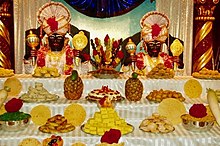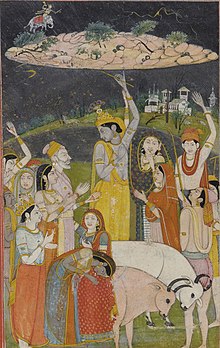Goverdhan puja, or Annakut or Annakoot (translated as “a mountain of food”) as it is also known, is a Hindu festival in which devotees prepare and offer a large variety of vegetarian food to the murtis ofParamatma(God) as a mark of gratitude. For Vaishnavas, this day commemorates the incident in the Bhagavata Puran whenKrishna lifted Goverdhan hill on his pinky to provide the villagers of Vrindavan shelter from torrential rains. The incident is seen to represent how God will protect all devotees who take singular refuge in him. Devotees offer a mountain of food, metaphorically representing the Govardhan hill, to God as a ritual remembrance and to renew their faith in taking refuge in God.[1] The festival is observed by many Hindu denominations, but is particularly prominent among the Vallabh Sampradaya (Pushtimarg), the Gaudiya Sampradaya of Chaitanya, and the Swaminarayan Sampradaya. The Annakut festival occurs on the first lunar day of Shukla Paksha (bright fortnight) in the Hindu calendar month of Kartik, which is the fourth day of Deepawali (Diwali), the Hindu festival of lights, and also the first day of the Vikram Samvat calendar.
The 2016 date for this observance is October 31.
Origins of Govardhan Puja and Annakut
Krishna spent most of his childhood in Braj, a place devotees associate with many of Krishna’s divine and heroic exploits with his childhood friends. One of the most significant incidents, described in the Bhagavata Purana, involves Krishna lifting Mount Govardhan, a low hill situated in the middle of Braj. According to the Bhagavata Purana, forest-dwelling cowherds living close to Govardhan used to celebrate the autumn season by paying respect to Indra, the god of rain and storm. Krishna did not approve of this since he desired that the villagers not pray to distant gods but rather give appreciation to avatar of God present before them. He therefore initiated a festival that paid respect to Mount Govardhan by preparing a 'giriyajna' - a "great offering of foods and delicacies to the mountain" Krishna then assumed the form of a mountain himself and accepted the villagers' offerings. Indra was angered upon seeing the villagers' devotion diverted away from him and toward Krishna. and directed a lightning storm and a torrential downpour upon the village for days. To protect the villagers from this calamity, Krishna lifted Mount Govardhan on his pinky finger to and had the entire village come under the hill to take shelter from the storm. Indra, after causing torrential rains for seven days, ultimately gave up and bowed to Krishna’s superiority. This story is one of the most recognizable in the Bhagavata Purana.
Govardhan has since become a major pilgrimage site in Braj for devotees of Krishna. On the day of Annakut, devotees circumambulate the hill and offer food to the mountain—one of the oldest rituals in Braj. The circumambulation consists of an eleven-mile trek dotted along the way with several shrines, before which devotees place flowers and other offerings.
Families create an image of Giriraj Govardhan (the mountain) from cow dung, adorning it with miniature cow figures as well as grass as twigs, representing trees and greenery. In the days leading up to Annakut, fifty-six food items (chappan bhog) are typically prepared and offered in the evening. Someone from a cow-herding caste officiates the ritual, circling the hill with a cow and a bull, followed by families in the village. They partake in the sanctified food after offering the food to the hill. he festival often draws a large crowd, including the Chaube brahmins of Mathura.
Rituals Of Annkut
Annakut is celebrated on the fourth day of Diwali. The fourth day of Diwali is also the first day of the new year in the Vikram Samvat calendar. Therefore, the rituals surrounding Annakut are closely linked with the rituals of the five days of Diwali. While the first three days of Diwali are days of prayer to sanctify wealth and invite greater wealth into the devotee’s life, the annakut day is a day of offering gratitude for God’s beneficence
Goverdhan Puja
Govardhan Puja is a principal ritual performed during Annakut. Although some texts treat Govardhan Puja and Annakut as synonymous, the Govardhan Puja is one segment of the day-long Annakut festival.
There are many variants of how Govardhan Puja is performed. One ritual involves making small mounds of cow dung or dirt symbolizing Mount Govardhan, which are then adorned with flowers and later worshipped by circumambulating around them. Prayers are also made to Lord Govardhan.
As described in the Bhagavata Purana , Govardhan Puja is chiefly identified with Krishna lifting the Govardhan Hill on his finger to protect those who sought his refuge from Indra’s torrential rage.
Main Annkut Festival
In many mandirs, or Hindu places of worship, 'Annakut' is offered to the [Murtis], or Deities, on this day. A vast array of vegetarian foods is traditionally arranged in tiers or steps in front of the deities. Usually, the sweets are placed nearest to the Deities. As the tiers descend, other foods such as 'dal', vegetables, pulses and fried savory foods are arranged. A mound of cooked grains, symbolic of Mount Govardhan, is placed in the center. In Swaminarayan shikharbaddh mandirs, sadhus begin to arrange the Annakut in the morning and finish before noon.
Thaal
In all Swaminarayan mandirs, sadhus and devotees then sing 'Thaal' - kirtans or devotional hymns composed by the poet paramhansas of Swaminarayan. These kirtans describe the food items, and are about praying to the Deities to accept the food. The singing lasts for about an hour, and is followed by a grand arti. Afterwards, devotees do puja and circumambulate the Deities and offered food. In some mandirs, Arti is performed several times in the day as long as the Annakut offerings remain before the Deities. In the evening, devotees take portions of the Annakut as prasad, sanctified food, that has been offered to God and is received as his mercy.
In certain mandirs, especially in Mathura and Nathadwara, the murtis are also given a milk bath before being and dressed in elegant clothes and ornaments.
Vishvakarma Puja
Some craftsmen pay reverence to their tools and machinery on the day of Annakut.
Annkut Celebrations Today
Hindus throughout the world actively celebrate Annakut as a part of Diwali and, most frequently, pair the Annakut celebration with the Govardhan Puja performed on fourth day of Diwali celebrations. Hindus also view Annakut as a time to transmit religious and cultural values to children, ask for forgiveness from God and express devotion towards God. Annakut is celebrated with diyas (small oil lamps) and rangoli, decorative art on the ground made from colored rice, colored sand, and/or flower petals. Many distinct food items, sometimes numbering in the hundreds or thousands, are offered to deities during Annakut. For example, 250 kilograms of food were offered to Lord Krishna at the ISKCON temple in Mysore, India in 2009. Although Annakut is most often associated with Lord Krishna, other deities are also focal points. At the Shree Mahalakshmi Mandir in Mumbai, India, 56 sweets and food items are offered to Mataji and then distributed as Prasad to more than 500 devotees.
The Annakut festival is also celebrated annually at approximately 3,850 BAPSMandirs and centers throughout the world in a day-long event. During the festival, Swaminarayan devotees prepare and offer a large variety of vegetarian food to Hindu deities including Swaminarayan and Krishna, among others. The Annakut festival at BAPS mandirs is often the largest festival of the year. Visitors learn about Hindu spirituality, offer prayers for the new year, partake in the prasad, or sanctified food, and engage in other devotional activities. A devotee at the BAPS Swaminarayan Mandir in Leicester, England, which organizes the Annakut festival every year, describes Annakut as being a forum where spiritual aspirants can reaffirm their appreciation for the role God plays in their lives. These gatherings also represent an opportunity to reaffirm a sense of community. At the BAPS Swaminarayan Mandir in Neasden, England in 2004, 1247 vegetarian dishes were assembled and offered to the deities during the Annakut celebrations in 2000 at the BAPS Swaminarayan Mandir in Neasden, England.



No comments:
Post a Comment